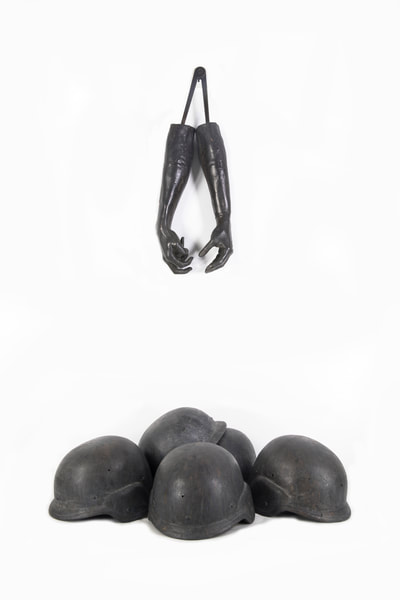
Sara Rahbar makes art out of the detritus of war. She is a mixed media artist whose sculpture and installation pieces take broken, implements of war, pieces of uniform and gear and recreates them into art. Her work is both personal and broad in its scope. Pieces reflect her experiences but they also embody the broader, shared, human experience.
Rahbar, an American artist born in Iran, lives and works in New York City. Her work will be show at NADA Miami 2018 (December 6 to 9) by Carbon.12 Gallery (Dubai). Her work with cast off martial items began early for her.
“From the very beginning I’ve always been attracted to these kinds of objects. I’m sure it has something to do with my past but I never overthink it. For me working is very instinctual, very raw and natural,” she says. “I began with the American flag and remnants from different wars. Now it’s cast bronze body parts, tools and collected objects but in the end they all touch on the same subjects: love, violence, control, the human condition. The objects and mediums may change but these subjects have always played a very significant role in my work. The foundation of it all are my emotions & memories; that is where everything begins.”
Knowing she was born, and left, Iran during a tumultuous period tends to lend credence to the notion that this is the root of her art but it isn’t necessarily that, or at least that alone.
“I don’t remember much and in general I don’t like to linger in the past. I let it all go a long time ago. But you know how it is we accumulate so much from living, from being out there in the world,emotions, memories and they always pop up in the work somehow. Sometimes I am aware of it and sometimes I’m not,” she says. “The work is a reflection of me of my life -of all the things that I’ve seen, recorded, felt & held onto all these years. And just like I have an accumulation of memories and emotions- my work is an accumulation of used and lived objects, neatly placed and attached together in a way that makes sense to me.”
Find out more at sararahbar.com
“She is a wonderful artist and I love her work -but my pieces are very different from hers. I use very specific objects--weapons and body parts. Also there’s a lot of metal in these pieces and Nevelson’s pieces were primarily wood.” says Rahbar. “These days I primarily work with wood and metal they are strong materials-and I like that I don’t like weak things. I don’t like things that break.”
Rahbar says she talks about workers, soldiers and the people just trying to survive. Geography, interactions and what remains after trauma are all part of her art.
“There are a lot of ideas that run through my mind when I collect these objects, but in the end when they’re in my studio they very organically come together and wind up becoming these historical totem poles or wall pieces,” she says. “I feel like I’m recording a history with these pieces; some of these objects are from World War I and II some of them are tools are from the 18th and 19th century. I feel such a relatedness to these objects and subjects. It all stems from somewhere deep down inside of me. It’s very hard to put into words.”
Like most art, the reaction of viewers comes from the viewer as much as it does from the art. Looking at Rahbar’s art is likely to inspire thought and a response. Different people will have different feelings about the work. This is, however, not the artist’s concern.
“I have received all different kinds of reactions to the work. But I don’t really focus on that too much. Once I make the piece I let it go.” says Rahbar. “I don’t focus on what it means and what people think of it. I’m focused on the bodies of work--the bigger picture and mainly the next piece. It’s always about the next piece.”
“I work with this amazing foundry in New York--Modern Art Foundry in Astoria, Queens. They have been around forever and I love working with them,” she says. “I cast my own body parts and use them in my various bodies of work. Sometimes they are attached to various collected objects and sometimes they are just on their own.”
She used to use prosthetics in her work but decided she needed skin, fingertips and veins.
“I needed curled feet and hands frozen in stressful positions--more human and authentic looking arms and legs,” she says. “That’s when I decide to just cast my own. I love working with bronze.“
There is something painful, something traumatic, in Rahbar’s art, in addition to the beauty. Yet she never recalls any temptation to create art of a more mundane sort.
“I’ll never forget this documentary that I watched years ago on Francis Bacon and they asked him the same kind of thing and he said something along the lines of 'flowers are also very tragic and sad because eventually they slowly wither away and die right before our eyes'.” she says. “I’ve had my share of trauma--the work is my catharsis, it heals me. It’s helped me to work through it and I’m at peace now.”
She is vegan and meditates after battling years of pain from addiction and depression.
“I’m in a better place now-and I have found that in facing the pain rather than running away from it or numbing myself to it. I’ve been able to create this body of work and heal myself in the process,” she says. “The work has been the only thing that has saved me from myself--that and my mother & brother. They have always been my rocks. I would not have made it this far without them.”






 RSS Feed
RSS Feed